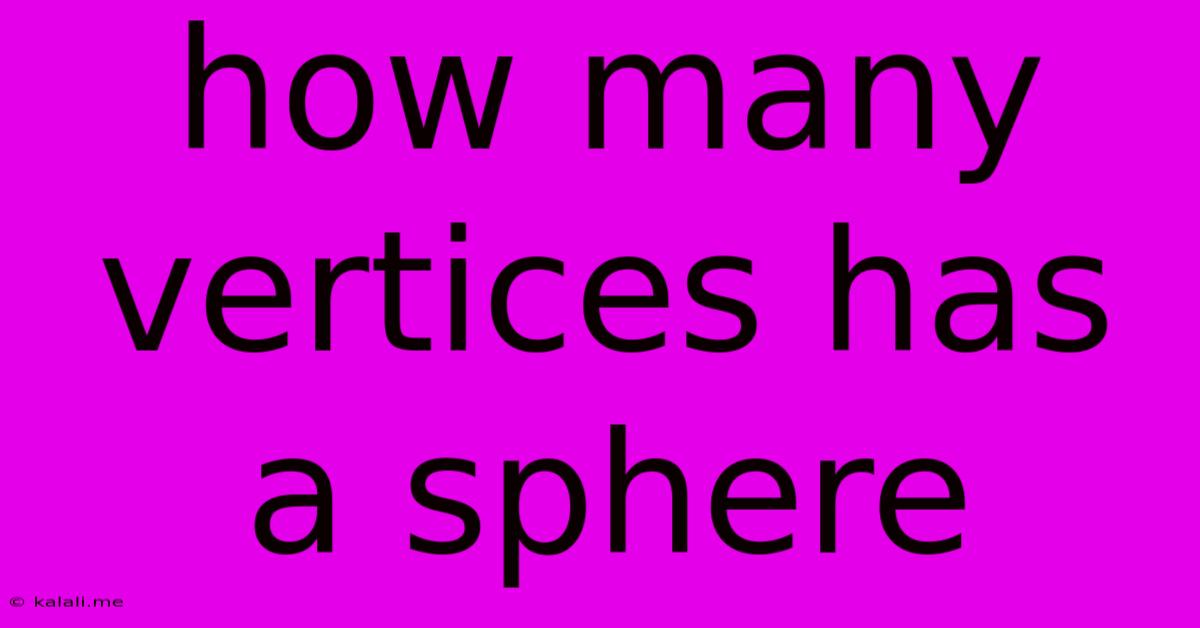How Many Vertices Has A Sphere
Kalali
May 09, 2025 · 3 min read

Table of Contents
How Many Vertices Does a Sphere Have? The Surprising Answer
A sphere, that perfectly round three-dimensional object, is a fundamental shape in geometry. But when we delve into its properties, a seemingly simple question can lead to surprising insights: How many vertices does a sphere have? The answer isn't as straightforward as you might think. This article will explore the concept of vertices, the unique nature of a sphere, and ultimately clarify the number of vertices it possesses.
A vertex, in simple terms, is a point where two or more lines or edges meet. Think of the corners of a cube – those are vertices. We commonly associate vertices with polygons and polyhedra, shapes with flat faces and straight edges. A sphere, however, differs significantly. It's a curved surface defined by all points equidistant from a central point (the center of the sphere). It has no edges or corners in the traditional sense.
Therefore, a sphere has zero vertices.
This might seem counterintuitive at first, especially if you're accustomed to thinking about shapes with distinct corners. The absence of vertices is a key characteristic distinguishing a sphere from polyhedra like cubes, pyramids, or octahedrons. These polyhedra have clearly defined vertices where their edges intersect. A sphere, on the other hand, is a completely smooth, continuous surface.
Understanding the Differences Between Spheres and Polyhedra
The contrast between a sphere and a polyhedron is crucial for understanding the concept of vertices. Consider these differences:
- Flat Faces vs. Curved Surface: Polyhedra have flat faces, while a sphere has a continuously curved surface.
- Edges vs. No Edges: Polyhedra have edges where faces meet; a sphere has no such edges.
- Vertices vs. No Vertices: Polyhedra possess vertices, the points where edges intersect; a sphere, possessing neither edges nor corners, has zero vertices.
This distinction highlights the importance of defining the terms accurately. The concept of a vertex is inherently tied to the existence of edges and corners, features that are absent in a sphere.
Mathematical Representation and Implications
In mathematical descriptions of spheres, we often use equations to define its surface. These equations do not involve points of intersection or corners, further reinforcing the idea that a sphere has no vertices. This characteristic has significant implications in various fields, including:
- 3D Modeling and Computer Graphics: Representing a sphere in computer graphics often utilizes techniques that approximate its curved surface using many small polygons. While these polygons have vertices, the underlying sphere itself does not.
- Calculus and Geometry: Calculations related to surface area and volume of a sphere rely on integral calculus, dealing with continuous functions rather than discrete points (vertices).
Conclusion: The Smooth Perfection of a Zero-Vertex Sphere
In conclusion, the answer to the question, "How many vertices does a sphere have?" is definitively zero. This seemingly simple question leads to a deeper understanding of the fundamental differences between curved surfaces and polyhedra, highlighting the unique characteristics of this fundamental geometric shape. The absence of vertices is a key aspect of what defines a perfect sphere.
Latest Posts
Latest Posts
-
How Many Days In A Million Minutes
Jul 14, 2025
-
How Many Days Is In 11 Weeks
Jul 14, 2025
-
How Many Grams Are In One Tola Gold
Jul 14, 2025
-
How Many Oz In A Pound Of Freon
Jul 14, 2025
-
How Many Years Are In A Millennia
Jul 14, 2025
Related Post
Thank you for visiting our website which covers about How Many Vertices Has A Sphere . We hope the information provided has been useful to you. Feel free to contact us if you have any questions or need further assistance. See you next time and don't miss to bookmark.